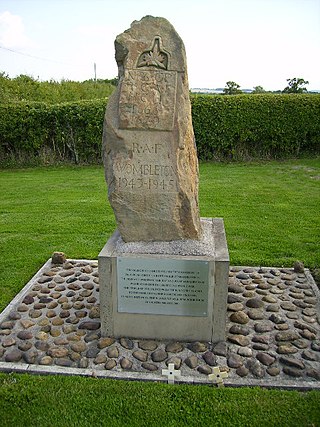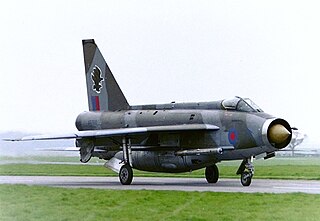
Royal Air Force Kirmington or more simply RAF Kirmington was a Royal Air Force station located 6.2 miles (10.0 km) north east of Brigg, Lincolnshire and 11 miles (18 km) south west of Grimsby, Lincolnshire, England.

Royal Air Force Station Wombleton or RAF Wombleton is a former Royal Air Force station located 3.8 miles (6.1 km) east of Helmsley, North Yorkshire and 11.8 miles (19 km) north east of Easingwold, North Yorkshire, England.

Royal Air Force East Kirkby or more simply RAF East Kirkby is a former Royal Air Force station near the village of East Kirkby, south of Horncastle in Lincolnshire, just off the A155. The airfield is now home to the Lincolnshire Aviation Heritage Centre air museum.

No. 26 Squadron of the Royal Air Force was formed in 1915 and was disbanded for the last time in 1976.
Royal Air Force Carnaby or more simply RAF Carnaby is a former Royal Air Force emergency landing strip that offered crippled bombers a safe place to land near the English coast during the Second World War. It was situated 2 miles (3.2 km) south-west of Bridlington, East Riding of Yorkshire.

Royal Air Force Wendling or RAF Wendling is a former Royal Air Force station located 4 miles (6.4 km) north west of East Dereham, Norfolk, England.
Royal Air Force Bircotes or more simply RAF Bircotes is a former Royal Air Force satellite airfield located within South Yorkshire, England. Although it was named after the town of Bircotes which is in Nottinghamshire.
Bruce Barrymore Halpenny was an English military historian and author, specializing in airfields and aircraft, as well as ghost stories and mysteries. He was also a broadcaster and games inventor.

Royal Air Force Elsham Wolds or more simply RAF Elsham Wolds is a former Royal Air Force station in England, which operated in the First World War and the Second World War. It is located just to the north east of the village of Elsham in north Lincolnshire.

Royal Air Force North Killingholme or more simply RAF North Killingholme is a former Royal Air Force station located immediately west of the village of North Killingholme in North Lincolnshire, England.

Royal Air Force station Skipton-on-Swale or more simply RAF Skipton-on-Swale is a former Royal Air Force station operated by RAF Bomber Command during the Second World War. The station was located at Skipton-on-Swale 4 miles (6.4 km) west of Thirsk, North Yorkshire, England. The village of Sandhutton is located just to the east. RAF Skipton-on-Swale was a sub-station of RAF Leeming.

Royal Air Force Bardney or RAF Bardney is a former Royal Air Force station located 1.7 miles (2.7 km) north of Bardney, Lincolnshire, England and 10.2 miles (16.4 km) east of the County town of Lincoln. It was built as a satellite to RAF Waddington in 1943 and the airfield closed in 1963.

Royal Air Force Binbrook or RAF Binbrook was a Royal Air Force station, now closed, located near Binbrook, Lincolnshire, England. The old domestic site has been renamed to become the village of Brookenby. RAF Binbrook was primarily used by Bomber Command in the Second World War. The Central Fighter Establishment moved to Binbrook from RAF West Raynham between 1959 and 1962 and two English Electric Lightning squadrons were stationed there between 1965 and 1988.

Royal Air Force Hibaldstow or more simply RAF Hibaldstow is a former Royal Air Force satellite station located south of Hibaldstow in Lincolnshire and 8.3 miles (13.4 km) south east of Scunthorpe, Lincolnshire, England.
Royal Air Force Firbeck or more simply RAF Firbeck is a former Royal Air Force station located west of Firbeck, South Yorkshire, England.
Royal Air Force Doncaster or more simply RAF Doncaster, also referred to as Doncaster Aerodrome, is a former Royal Air Force station near Doncaster, South Yorkshire, England.

RAF Atherstone was a former Royal Air Force satellite station located 2.25 miles (3.62 km) south of Stratford-upon-Avon, Warwickshire, England, 7.5 miles (12.1 km) north-west of Shipston on Stour.

Beverley Aerodrome, was a First World War era Royal Flying Corps training depot, in Bishop Burton, East Riding of Yorkshire, England. The site, like many others in Yorkshire, was developed from a racecourse on the western edge of Beverley, along the road between Beverley and York. Initially set up as a location for squadrons employed in Home Defence (HD), particularly preventing Zeppelin attacks on Hull and the east coast, the site later became a training depot for squadrons and flights who would then deploy to the front line. Beverley was also used as a standing up and transfer location for six Canadian Reserve Squadrons in 1917, all of which were posted to Canada. Beverley Aerodrome was used between 1916 and 1920, with the RAF later using the site in the 1930s in a non-flying role.

The Type-C hangar is a specific design of aircraft hangar built by the Royal Air Force during its expansion period of the 1930s. The hangar type generally measured 300 feet (91 m) in length, with a width of 152 feet 5 inches (46.46 m), and a clear height of 35 feet 4 inches (10.77 m). Whilst the type was designed, built and used during the expansion programme, installation of type-C hangars continued into the Second World War. By 1944, it was determined that at least one type-C hangar existed in 64 RAF expansion period airfields, which were open at that time.


















